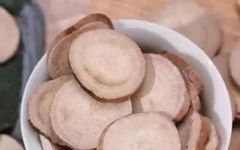Author: Fu Yu, First Affiliated Hospital of Guangzhou Medical University
Editor: Fu Yongjin, Chief Pharmacist of Jinan University Affiliated Guangzhou Red Cross Hospital
Bai Shao (White Peony)
Bai Shao has a long history of application in Traditional Chinese Medicine (TCM), first recorded in the Shen Nong Ben Cao Jing, where it is classified as a medium-grade herb with a “bitter and neutral” flavor. It is indicated for abdominal pain due to evil qi, alleviates blood stasis, breaks up cold and heat accumulation, treats hernias, stops pain, promotes urination, and tonifies qi. It grows in river valleys and hilly areas. The famous physician and pharmacologist Tao Hongjing from the Southern Liang Dynasty first proposed the distinction between Bai Shao and Chi Shao in his work Ben Cao Jing Ji Zhu, noting that the best Bai Shao comes from Bai Mountain, Jiang Mountain, and Mao Mountain, which are long and white, while other areas produce more Chi Shao, which is smaller and has a lower quality. Although he did not clearly differentiate between Bai Shao and Chi Shao, he mentioned the differences in the properties, origin, and efficacy of the herbs.In summary, before the Liang Dynasty, there was only Shao Yao (Peony), without the distinction of Bai Shao and Chi Shao.After Tao Hongjing, TCM practitioners began to recognize the differences between Bai Shao and Chi Shao based on the accumulated experiences of previous generations. In modern times, the Chinese Pharmacopoeia no longer records Shao Yao but lists Bai Shao and Chi Shao as separate herbs.So, what are the differences between Bai Shao and Chi Shao, which originate from the same root? Historical texts and medical books provide various records of their efficacy differences, as follows:In the Jin Dynasty, Annotation on Treatise on Cold Damage: “Shao Yao, Bai tonifies while Chi purges; Bai gathers while Chi disperses.”In the Ming Dynasty, Compendium of Materia Medica: “Bai Shao tonifies the spleen, can purge wood from the earth. Chi Shao disperses evil, can move stagnation in the blood.”In modern times, Ben Cao Zheng Yi explains more thoroughly: “One is for tonifying blood and nourishing the liver and spleen yin, while gathering the scattered spleen qi, which is Bai Shao; the other is for expelling blood stasis, breaking up accumulation, and descending, which is Chi Shao.”From the above, we can see that Bai Shao is primarily for tonifying and gathering, capable of nourishing liver blood and softening, gathering, and soothing the liver, while also calming the spleen; whereas Chi Shao is primarily for purging and dispersing, excelling in clearing heat and cooling blood, can clear heat from the blood, invigorate blood circulation, and also purge liver fire. “Purging wood from the earth” refers to the ability to regulate the spleen and stomach while promoting liver and gallbladder function.
01
Difference One
|
– |
Bai Shao |
Chi Shao |
|
Source Plant |
Dry root of the Peony plant (Paeonia lactiflora) |
Dry root of the Peony plant or Chi Shao (Paeonia veitchii). |
|
Origin |
Mainly produced in Zhejiang, Anhui, Sichuan, etc. |
Grown nationwide, mainly produced in Inner Mongolia, Liaoning, Hebei, Gansu, etc. |
|
Those from Zhejiang are called Hang Bai Shao, known for the best quality; |
||
|
Those from Anhui are called Bo Bai Shao, with the largest yield; those from Sichuan are known as Chuan Bai Shao, also with a large yield. |
||
|
Processing Method |
Harvested in summer and autumn, cleaned, removing the head, tail, and fine roots, boiled in water to remove the outer skin or peeled before boiling, then dried. |
Harvested in spring and autumn, removing the rhizome, fibrous roots, and soil, then dried. |
|
Herb Characteristics (Slices) |
Thin, round slices. Surface is light brownish-red or whitish. The cross-section is slightly brownish-red or whitish, with distinct layer rings and slightly raised vein patterns arranged radially. Slight aroma, with a slightly bitter and sour taste. |
Thin, round slices, with a brownish outer skin. The cross-section is powdery white or pink, with a narrow skin and distinct radial wood texture, some with cracks. |
|
Flavor, Properties, and Functions |
Bitter, sour, slightly cold. Enters the liver and spleen meridians. Nourishes blood, regulates menstruation, astringes yin, stops sweating, softens the liver, alleviates pain, and pacifies liver yang. Used for blood deficiency, menstrual irregularities, spontaneous sweating, night sweats, flank pain, abdominal pain, limb cramps, headaches, and dizziness. |
Bitter, slightly cold. Enters the liver meridian. Clears heat, cools blood, disperses stasis, and alleviates pain. Used for heat entering the blood, warm toxin causing rashes, vomiting blood, nosebleeds, red and painful eyes, liver qi stagnation with flank pain, dysmenorrhea, abdominal pain from masses, trauma, and abscesses. |
|
Unsuitable Populations |
This herb is cold in nature, thus unsuitable for those with external wind-cold, internal injury from cold, spleen and stomach deficiency with cold, kidney yang deficiency, and women with menstrual irregularities due to deficiency and cold; postpartum women should not take it in large amounts. Those with qi deficiency and spontaneous sweating, or yang deficiency with sweating should avoid it. |
This herb clears heat and cools blood, and its strong blood-invigorating and stasis-dispersing effects make it unsuitable for all blood deficiency conditions, diarrhea, postpartum lochia that has ceased, abdominal pain that has stopped, and abscesses that have ruptured. |
|
Compatibility Contraindications |
Should not be used with Li Lu (Veratrum) together. |
02
Difference Two
In addition to the differences in medicinal efficacy, Bai Shao and Chi Shao also have the following distinctions:
1
As seen from the table, Bai Shao and Chi Shao have similar sources, but due to their different growing environments and harvesting and processing methods, they possess different medicinal properties and therapeutic effects.
Research shows that Bai Shao and Chi Shao contain similar chemical components, mainly monoterpenes and their glycosides (such as paeoniflorin, paeonol glycoside, etc.), triterpenes (such as oleanolic acid), flavonoids (such as quercetin), volatile oils (such as paeonol), tannins, and various other chemical constituents, but the content of these chemical components varies between the two herbs.
2
3
Modern pharmacological studies indicate that Bai Shao and Chi Shao both exhibit analgesic, anti-inflammatory, antioxidant, anti-thrombotic, anti-depressant, and anti-atherosclerotic effects, and also have antioxidant, anti-inflammatory, anti-cancer, and blood sugar-lowering effects.
Bai Shao is superior to Chi Shao in anti-inflammatory, antispasmodic, analgesic, and blood-nourishing effects;
while Chi Shao has stronger effects in anti-platelet aggregation, vasodilation, and improving blood rheology.
Consumption Methods:
Bai Shao and Chi Shao are not only highly valuable medicinal herbs but also nutritious food ingredients. Here are a few simple consumption methods:
01
Bai Shao Stewed Pork Hock
Ingredients: 25g Bai Shao, 500g pork hock, 5ml cooking wine, salt, monosodium glutamate, ginger slices, and green onion segments to taste.
Method: Stew the above ingredients in a pot until cooked.
Efficacy: Nourishes blood, regulates menstruation, softens the liver, and alleviates pain, effective for treating menstrual irregularities, excessive bleeding, and yin deficiency heat.
02
Bai Shao and Wheat Jujube Porridge
Ingredients: 150g glutinous rice, 30g jujube, 20g Bai Shao, 25g wheat, 15g honey.
Method:
1. First, wash the glutinous rice, soak it in cold water for 1 hour, then drain; pit and wash the jujube, cut in half.
2. Clean the wheat and Bai Shao, place them in a cloth bag, tie it tightly, and put it in a pot with an appropriate amount of water, boil, then simmer for 30 minutes.
3. Remove the herb bag, add the jujube and glutinous rice to the pot, bring to a boil, then simmer until the rice is soft, and stir in honey until well mixed.
Efficacy: Nourishes blood, benefits the kidneys, strengthens the spleen and stomach, suitable for post-illness weakness, liver cirrhosis, women with blood deficiency, and cardiovascular patients.
03
Poria and Chi Shao Tea
Ingredients: 5g Poria, 3g Chi Shao, 3g flower tea.
Method: Brew with 250ml boiling water for 10 minutes before drinking, and continue to brew until the flavor is mild.
Efficacy: A traditional medicinal tea formula. Functions to strengthen the spleen, promote urination, and invigorate blood, used for edema, blood stasis, and ear-related dizziness.
-END-
Some images in this article are sourced from the internet for public welfare dissemination. Thanks to the authors of the images; if there is any infringement, please contact us for removal.

This article is an original work by “PSM Yao Dun Public Welfare”; please leave a message for reprinting.
Review Experts:
First Review: Ye Zhenzhen, Guangdong Pharmaceutical Association, First Affiliated Hospital of Guangzhou Medical University
Second Review: Jiang Guojie, Guangdong Pharmaceutical Association, First Affiliated Hospital of Guangzhou Medical University

References
[1] Shi Suying, Du Qianqian, Xing Lihua, Yu Nianjun. The Evolution of Materia Medica in the Distinction Between Bai Shao and Chi Shao [J/OL]. Chinese Medicinal Materials, 2021(10):2473-2478.
[2] National Pharmacopoeia Commission. Pharmacopoeia of the People’s Republic of China [M]. Volume 1. Beijing: China Medical Science Press, 2020:108, 165.
[3] Wang Qian, Li Liutong, Ma Yongben, Wu Lingfang, Niu Liying. Comparative Study of Chemical Components and Pharmacological Effects of Bai Shao and Chi Shao and Predictive Analysis of Quality Markers [J]. Chinese New Drug Journal, 2021,30(12):1093-1098.


Search for articles related to Bai Shao and Chi Shao

